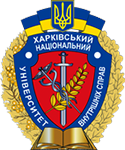Legal aspects of functional security standardisation of the Internet of Things
Abstract
IoT technologies provide smart things with the ability to make decisions in the management of physical objects using intelligence and consensus. To support the Internet of Things, technologies such as built-in devices, cloud and fog computing, big data processing, machine learning, and artificial intelligence are used to produce intelligent physical objects. A review of existing security infrastructures for IoT-based intelligent environments shows that every connected device can be a potential entry point for an attack.
An overview of the key aspects of security standards for smart environments based on the Internet of Things has been provided in the following areas: potential solutions, intelligent environments, limits of security assessment, open issues and challenges. Additional research on the development of methodological and technological standardisation measures in the field of interoperability of heterogeneous IoT devices is an urgent task in order to start further discussions on the development of new security standards and certification infrastructure for smart environments based on the IoT.
Based on the analysis of the existing problems of implementing the Internet of Things, the methodological and technological features of legal regulation of intellectual environments have been studied. The structures of standardisation of networks and services of the IoT environments at the regional, European and global international levels have been considered.
The architecture of the Internet of Things environments has been defined as a multi-level, heterogeneous system with a complex topology and the use of innovative technologies. The single phenomenon of IoT security has been identified as a complex concept that includes functional security and information security with their interconnection, contradictions, challenges and risks.
The functional security of the Internet of Things has been studied in terms of the security function, security completeness and resilience, which are subject to regulation in the technical requirements for the product being designed. An aspect model of IoT interoperability has been presented and examples of its application in terms of interrelated components (transport, syntactic, semantic, behavioural, and policy aspects) have been given.
An assessment of generally accepted practices and risks of creating regulatory documents (standards, instructions, methodological materials) in the field of functional security of the Internet of Things has been carried out. Recommendations for the introduction of a scientifically based approach to national standardisation of IoT security and measures to address the problem of interoperability of heterogeneous IoT devices have been provided.
Downloads
References
Atlam, H. F., & Wills, G. (2020). IoT Security, Privacy, Safety and Ethics. In M. Farsi, A. Daneshkhah, A. Hosseinian-Far, & H. Jahankhani (Eds), Digital Twin Technologies and Smart Cities. https://doi.org/10.1007/978-3-030-18732-3_8.
Cerf, V. G., Ryan, P. S., Senges, M., & Whitt, R. S. (2016). IoT safety and security as shared responsibility. Business Informatics, 1(35), 7–19. https://doi.org/10.17323/1998-0663.2016.1.7.19.
Chintham, S., Poladi, P. K., & Kumar, S. N. (2018). Security Challenges and Issues of the IoT System. Indian Journal of Public Health Research & Development, 9(11), 748–753. https://doi.org/10.5958/0976-5506.2018.01551.6.
Diavil, A. H., & Nozdrina, L. V. (2020). The Internet of Things as a component of Industry 4.0: a project approach. Bulletin of the University of Banking, 3(39), 85–93.
Domracheva, K. O., Dovzhenko, N. M., and Dmytrenko, V. V. (2019). Analysis of technologies and connection standards for the IoT network. Scientific Notes of the State University of Telecommunications, 3(55), 54–62. https://doi.org/10.31673/2518-7678.2019.0305462.
Ivanov, A. H., & Bershadska, D. R. (2022). Legal regulation of artificial intelligence in the EU: The “European approach” and human rights challenges. Juridical Scientific and Electronic Journal, 10, 697–699. https://doi.org/10.32782/2524-0374/2022-10/175.
Karie, N. M., Sahri, N. M., & Haskell-Dowland, P. (2020, April 21). IoT Threat Detection Advances, Challenges and Future Directions [Conference presentation abstract]. Workshop on Emerging Technologies for Security in IoT. https://doi.org/10.1109/ETSecIoT50046.2020.00009.
Karie, N. M., Sahri, N. M., Yang, W., Valli, C., & Kebande, V. R. (2021). A review of security standards and frameworks for IoT-based smart environments. IEEE Access, 9, 121975–121995. https://doi.org/10.1109/ACCESS.2021.3109886.
Kebande, V. R., Karie, N. M., & Venter, H. S. (2018). Adding digital forensic readiness as a security component to the IoT domain. International Journal on Advancer Science Engineering and Information Technology, 8(1). https://doi.org/10.18517/ijaseit.8.1.2115.
Khlaponin, D. Yu. (2018). Peculiarities of regulatory and legal regulation of cyber-physical systems in the leading countries of the world. Law and Society, 2(2), 145–151.
Ning, H., Zhang, Z., & Daneshmand, M. (2021). PhiNet of Things: Things Connected by Physical Space From the Natural View. IEEE Internet of Things Journal, 8(11), 8680–8692. https://doi.org/10.1109/JIOT.2020.3040441.
Ostapenko, V. O. (2017). Methods of assessment of functional safety wireless sensor network of plant condition. Artificial Intelligence, 3–4, 32–43.
Pal, S., Hitchens, M., Rabehaja, T., & Mukhopadhyay, S. (2020). Security Requirements for the Internet of Things: A Systematic Approach. Sensors, 20(20). https://doi.org/10.3390/s20205897.
Puleko, I. V., & Yefimenko, A. A. (2022). Architecture and technologies of the Internet of Things. State University “Zhytomyr Polytechnic”.
Salman, T., & Jain, R. (2017). A Survey of Protocols and Standards for Internet of Things. Advanced Computing and Communications, 1(1). https://arxiv.org/ftp/arxiv/papers/1903/1903.11549.pdf.
Saracco, R. (2019). Digital Twins: Bridging Physical Space and Cyberspace. Computer, 52(12), 58–64. https://doi.org/10.1109/MC.2019.2942803.
Sethi, P., & Sarangi, S. R. (2017). Internet of Things: Architectures, Protocols, and Applications. Journal of Electrical and Computer Engineering, 1. https://doi.org/10.1155/2017/9324035.
Tiuria, Yu. I. (2022). Some aspects of building a regulatory framework for the administrative and legal regulation of activities related to the creation, implementation and use of artificial intelligence in Ukraine. Juris Europensis Scientia, 5, 25–28. https://doi.org/10.32782/chern.v5.2022.5.
Tokarieva, K. S., & Savliva, N. O. (2021). Peculiarities of legal regulation of artificial intelligence in Ukraine. Law Herald, 3(60), 148–153. https://doi.org/10.18372/2307-9061.60.15967.
Vermesan, O., & Friess, P. (2014). Internet of Things – From Research and Innovation to Market Deployment. River Publishers.
Copyright (c) 2023 P. S. Klimushyn, V. Ye. Roh, T. P. Kolisnyk

This work is licensed under a Creative Commons Attribution 4.0 International License.



